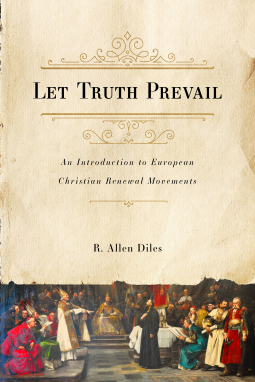
Let Truth Prevail
An Introduction to European Christian Renewal Movements
by R. Allen Diles
This title was previously available on NetGalley and is now archived.
Send NetGalley books directly to your Kindle or Kindle app
1
To read on a Kindle or Kindle app, please add kindle@netgalley.com as an approved email address to receive files in your Amazon account. Click here for step-by-step instructions.
2
Also find your Kindle email address within your Amazon account, and enter it here.
Pub Date Jul 13 2021 | Archive Date Jan 20 2022
Abilene Christian University Press & Leafwood Publishers | Abilene Christian University Press
Talking about this book? Use #LetTruthPrevail #NetGalley. More hashtag tips!
Description
Through the centuries, marginalized Christian renewal movements have challenged the status quo of the religious establishment, often at great cost. These nonmainstream religious movements generally receive little attention in standard introductions, but Let Truth Prevail tells their story, surveying the history, beliefs, and practices of various medieval and post-Reformation European renewal movements:
17th-century German Pietists
18th-century Scottish restoration movements
Hussites
Hutterites
Magisterial Protestants and Catholics
Mennonites
The Moravian Brethren
The Schwarzenau Brethren
Swiss Brethren
Taborites
The Unity of the Brethren
Waldensians
Allen Diles classifies these groups as restoration movements, calling attention to their enduring legacies. Each reacted against perceived corruptions in the church and sought to renew faithfulness to God’s truth and his intended ideals as they applied Scripture to their historical context.
Though Let Truth Prevail demonstrates the strengths of these renewal movements, the book also considers their limitations. Current readers can challenge their own self-understanding of history, God, faith, Scripture, and the practice of the Christian way by reflecting on these marginalized believers.
Available Editions
| ISBN | 9781684262410 |
| PRICE | $23.99 (USD) |
Average rating from 5 members
Featured Reviews
This book is, for all intents and purposes, an academic text exploring the beginnings of the restoration/reformation movements in Europe. There is an indirect tie-in to the Stone-Campbell movement in the United States of which I am a product of; so I found this history an extremely interesting review of how the various schismatic communities development the various beliefs that they came to hold. Each chapter introducing a movement and some of the founders and/or main players in the movement evolution. This includes something of a compare and contract against the predominant Catholic view as well as other Protestant churches … and it is remarkable how they will nearly all in alignment except for a few specific disagreements and it was the subsequent persecution that forced some of the major changes/conflicts. The author then sums up the chapter in a Legacy section that talks about where they went from there and closes with “Questions for Thought or Discussion” and a ton of reference notes. While some of the list of names and dates typical of a history text can be tough slogging, the terms and language used were clear and easily accessible/understood.
<spoiler>Introduction: The Concept of Restoration
Chapter 1: Setting the Stage: The Medieval Church and the Need for Reformation “in Head and in Members”
Chapter 2: “To Obey God Rather than Men”: The Waldensians
Chapter 3: “Truth Prevails over All”: The Czech Reformation Part 1
Chapter 4: “Jesus Christ, the Best Lawgiver”: The Czech Reformation Part 2
Chapter 5: “Faith, Love, and Hope”: The Unity of the Brethren (Unitas Fratrum)
Chapter 6: “For the Greater Glory of God”: The Protestant and Catholic Reformations of the Sixteenth Century
Chapter 7: “Given, Surrendered, and Sacrificed Wholly to God”: Evangelical Anabaptists Part 1
Chapter 8: “Overthrowing Religion and Civil Order”: Evangelical Anabaptists Part 2
Chapter 9: “A Personal Religion of the Heart”: Pietism, Schwarzenau Brethren, and the Moravian Brethren
Chapter 10: “No Such Thing as a National Church”: Scottish Restorationists
Afterword: “Yet More Truth to Break Forth from His Holy Word” </spoiler>
I was given this free advance reader copy (ARC) ebook at my request and have voluntarily left this review.
#LetTruthPrevail #NetGalley.
 Dylan S, Reviewer
Dylan S, Reviewer
When considering matters of my personal faith, I look for an answer from the past. One of those instances is when I consider how much of the Ancient Church should I base my own faith on. Diles book provided the answer in that I am not alone in this quest to seek the faith of the early Christians. People who purchase this book, will be in for a treat and a fast trip through the human history of the Church and the members who have sought to bring Christianity to its ancient roots. I would highly recommend this book to those who also may be seeking these same roots.
Let Truth Prevail is a survey of reform movements within the European church. The premise, which I agree with, is that over time the church tends to drift from its true mission and calling and God will bring along reformers and reform movements that will serve as course correctors. Sometimes these movements will spring from and remain within the larger church. Other times they will break off to create new churches and denominations.
Diles examines many of these movements, places them within their historical context, and then points out the strengths and weaknesses in each. Some of these movements I was more familiar with than others, but each is presented in a way that is readable, informative, and without any glaring bias. At the end of each chapter are reflection questions that would make this a good book for reading clubs, small groups, or as an undergrad textbook. The book was definitely worth my time and anyone interested in church history would do well to have it in their library.








